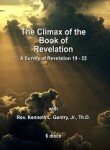Kenneth L. Gentry Jr.'s Blog, page 40
January 14, 2022
IS PRETERISM ANTI-SEMITIC? (2)
 PMW 2022-004 by Kenneth L. Gentry, Jr
PMW 2022-004 by Kenneth L. Gentry, Jr
This is part 2 of a series on preterism and anti-semitism. According to some, the New Testament is one embarrassing book. How can anyone believe it? Not only is preterism anti-Semitic, but so is the New Testament. Christianity just needs to fold up, pack it away, and leave the world alone.
This New Testament=anti-Semitism charge is according to secularists and liberal “theologians,” that is. But ironically, those evangelicals who charge preterism with anti-Semitism because of what they read among the secularists and liberals are shooting themselves in the foot.
To criticize the preterist interpretation of Revelation as anti-Semitic because of its strong teaching against the Jews requires that you also criticize the Gospels and Acts on the same basis. Those liberals who charge that Revelation’s denunciations of Israel are anti-Semitic must also charge the Gospels and Acts as such. In fact, virtually every contemporary academic study dealing with the history of anti-Semitism traces the roots of modern anti-Semitism to these books. See for example:
• John Dominic Crossan, Who Killed Jesus? Exposing the Roots of Anti-Semitism in the Gospel Story (San Francisco: HarperSanFrancisco, 1995) .
• Dan Cohn-Sherbok, The Crucified Jew: Twenty Centuries of Anti-Semitism (Grand Rapids: Eerdmans, 1992).
• T. A. Burkill, “Anti-Semitism in St. Mark’s Gospel,” NT 3 (1959): 34-52.
• W. R. Farmer, Anti-Judaism and the Gospels (Harrisburg, Penn.: Trinity, 1999).
• Riemund Bieringer, Didier Pollefeyt, and Frederique Vandecasteele, eds., Anti-Judaism and the Fourth Gospel (Louisville, Kent.: Westminster John Knox, 2001).
• L. T. Johnson, “The New Testament’s Anti-Jewish Slander and the Conventions of Ancient Polemic,” Journal of Biblical Literature 108 (1989): 419-41.
GREAT TRIBULATION: PAST OR FUTURE?
(Thomas Ice v. Ken Gentry)
Kregel Publications debate book on the nature and timing of “the great tribulation.” Both sides thoroughly cover the evidence they deem necessary for understanding “the great tribulation.” They then carefully interact with each other. Helpful introduction to the debate between futurism and preterism.
See more study materials at: www.KennethGentry.com
The New Testament in general
Jack T. Sanders writes that “whether or not Christian writers cringe at applying the term ‘anti-semitism’ to part of the New Testament, we must realize that it is that hostility that we are describing” (Sanders The Jews in Luke-Acts [Philadelphia: Fortress, 1987], xvi).
The Gospel of Matthew
Some scholars view Matthew a the “most severely ‘anti-Jewish” Gospels. For instance, Jewish scholar David Flusser comments on Matthew 8:11-12 regarding the “sons of the kingdom” being cast out: “This is a vulgar anti-Judaism of many members of the early Gentile church” (Judaism and the Origins of Christianity [Jerusalem: Magness, 1988. xxiii]).
Regarding Matthew 27:25, Galambush (an apostate Christian) (p. 59) laments: “It is hard to imagine a more anti-Jewish account than this ‘most Jewish’ gospel.” She also states that 1Th 2:14-16 “was slanderous in its original context and, in later years, disastrous in its consequences” (Julie Galambush, The Reluctant Parting: How the New Testament’s Jewish Writers Created a Christian Book [San Francisco: HarperSanFrancisco, 2005], 125).
Matthew 27:25 is of such concern that it played prominently in the following story. A May 21, 2000 Associated Press article commented on the re-writing of the decennial Passion Play in Oberammergau, Germany (which dates back to 1634). It was written so as to remove “anti-Semitic” aspects of the crucifixion account: “When enraged Temple leaders shouted ‘Crucify him! Crucify him!’ during a climactic scene at the premiere Sunday of the world’s most famous Passion play, dissenters defended Jesus for the first time: ‘Set him free!’ The revision is among a series of thoughtfully scripted changes introduced for the millennial production of the Oberammergau Passion play, acted roughly every decade since 1634. Many of the story’s most ardent critics now declare this version a milestone in decades-
long efforts expunge negative images of Jews. ‘I can say positively that it is a turning point,’ said Irving Levine, an interfaith expert for the American Jewish Committee, which has been working with the Anti-Defamation League since the 1960s to remove Jewish stereotypes from the Oberammergau play.”
In his article “Mel Gibson and the Gospel of Anti-Semitism” Charles Patterson (JewishVirtualLibrary.Org) writes: “The trouble with Mel Gibson’s film ‘The Passion’ is not the film itself, but the gospel story on which it’s based. The gospel story, which has generated more anti-Semitism than the sum of all the other anti-Semitic writings ever written, created the climate in Christian Europe that led to the Holocaust. Long before the rise of Adolf Hitler, the gospel story about the life and death of Jesus had poisoned the bloodstream of European civilization..” To ameliorate the situation, Gibson edited the film to drop the
In February 4, 2004, the New York Times published an article by Sharon Waxman titled: “Gibson To Delete A Scene In “Passion.’” That article also charged that Matthew 27:25 was anti-Semitic and dangerous. She writes: “Mel Gibson, responding to focus groups as much as to protests by Jewish critics, has decided to delete a controversial scene about Jews from his film, ”The Passion of the Christ,” a close associate said today. A scene in the film, in which the Jewish high priest Caiaphas calls down a kind of curse on the Jewish people by declaring of the Crucifixion, ‘His blood be on us and on our children,’ will not be in the movie’s final version, said the Gibson associate, who spoke on condition of anonymity…. Jewish leaders had warned that the passage from Matthew 27:25 was the historic source for many of the charges of deicide and Jews’ collective guilt in the death of Jesus.”
The Gospel of Luke
Weatherly opens his important defense of the historicity and moral character of Luke’s writings with these words: “Is the New Testament anti-Semitic?. . . As the question as been posed and answers sought, the Lukan corpus has become a particular focus of investigation” (Jon A. Weatherly, Jewish Responsibility for the Death of Jesus in Luke-Acts [Sheffield: Journal for the Study of the New Testament Supplemental Series 106, 1994], 13).
Luke repeatedly blames the Jews for Christ’s death: Lk 24:20; Acts 2:22-23, 36; 3:13-15a; 4:10; 5:28, 30; 7:52; 10:39; 13:27-29; Ac 26:10. And this is deemed the seed of full blown anti-Semitism by Josef Blinzler (The Trial of Jesus: The Jewish and Roman Proceedings Against Jesus Christ Described and Assessed from the Oldest Accounts. [Trans from 2d ed. by Isabel and Florence McHugh. Westminster, Maryland: Newman, 1959]) who writes: “It was repeatedly stated on the part of the Jews that, when all was said and done, modern antiSemitism was nothing else than the logical result of the Christian thesis that the Jews were guilty of the death of Jesus.”
THE HARROWING OF HELL
By Jay Rogers
This postmillennial book examines the power of the Gospel, not only to overcome all opposition, but to rise far above the powers of hell. The term “Harrowing of Hell” refers to idea that Christ descended into Hell, as stated in the Apostles’ Creed.
For more Christian educational materials: www.KennethGentry.com
The Gospel of John
Many critical scholars argue that John is the most anti-Semitic of the Gospels. For example:
• Rosemary Ruether, Faith and Fratricide: The Theological Roots of Anti-Semitism (New York: Seabury, 1974), 111-16.
• R. Fuller, “The ‘Jews’ in the Fourth Gospel,” Dialog 16 (1977): 35.
• E. J. Epp, “Anti-Semitism and the Popularity of the Fourth Gospel in Christianity,” CCAR Journal, 22:4 (Fall, 1975), 35-52.
• M. A. Getty, “the Jews and John’s Passion Narrative,” Liturgy 22:3 (March 1977): 6ff.
For anyone to charge preterism with antiSemitism requires that they also discredit the New Testament is antiSemitic. But that price should be too high for the Christian, just as its charge is too low for the liberal and secularist.
January 11, 2022
IS PRETERISM ANTI-SEMITIC? (1)
PMW 2022-003 by Kenneth L. Gentry, Jr.
 Preterism is anti-Semitic. Pure and simple. To the core, through-and-through. It denounces Jews and Israel. And it must do so to maintain its distinctive theology. It involves a persecutional mindset.
Preterism is anti-Semitic. Pure and simple. To the core, through-and-through. It denounces Jews and Israel. And it must do so to maintain its distinctive theology. It involves a persecutional mindset.
At least that is what prophecy populists maintain, and what a number of scholars (who should know better) argue. But why do they make this charge?
Preteristm teaches that several New Testament prophecies apply to the AD 70 destruction of the temple. Is preterism’s focus on the Jewish judgment in AD 70 anti-Semtic? This is a serious moral charge. How does the preterist postmillennialist answer it? Are we guilty of such a sin?
Before I can respond to the charge I must first consider the historical backdrop to it, then the actual moral charge deemed to be within the system.
The backdrop
Two issues merge today in prompting the anti-Semitism charge against preterism.
The first is the horrific Nazi holocaust that ruthlessly slaughtered so many Jews. This enormous evil has rightly impacted our psyche regarding both the suffering of the Jews and the sinfulness of man. Its impact is widely felt in biblical and theological studies, just as it is in historical, sociological, political, psychological, and other fields of academic endeavor.
The second is political correctness, with all of its absurdities and hyper-sensitivity. We are all familiar with this liberal mindset and its heightened sensitivity to any sort of perceived slight to any people group — except for Christians, especially evangelical Christians, and most especially white evangelical Christians. Combined with an extreme relativism, the very facts of history are either totally suppressed or radically reinterpreted in order to promote the new values inherent in this perspective.
BEFORE JERUSALEM FELL
Doctoral dissertation defending a pre-AD 70 date for Revelation’s writing (459 pp; pb). Thoroughly covers internal evidence from Revelation, external evidence from history, and objections to the early date by scholars.
See more study materials at: www.KennethGentry.com
In this sort of environment any promotion or defense of Christianity, especially regarding its truth claims and its history-altering impact, is fair game for intellectual derision and academic assault. The modern mind stands aghast that we believe Jesus Christ is “the way, the truth, and the life.” The notion of Jesus as the only Savior is an anathema that is condemned with all the vitriol that can be mustered — which is quite a bit.
The preterist “sin”
Furthermore, the preterist approach to NT prophecy makes the matter supposedly worse by (allegedly) adding the additional baggage of overt anti-Semitism. This is because preterists believe that two series of events from the first century are foundational to NT prophecy and the future development of human history. The first set of events involve the birth, life, work, death, resurrection, and ascension of Christ. The second includes the destruction of Jerusalem, the collapse of the Jewish temple, and the permanent cessation of the sacrificial system. (I should note, however, that as Richard Gaffin and others notes, the AD 70 judgment is really an extension of Christ’s first coming. Thus, technically these are not two series of events, but one elongated one.)
In the preterist system these two event-series dramatically demonstrate the wrath of God against Israel, combining to:
• legally effect the ending of the old covenant which was God’s revelation for governing Israel
• permanently disestablish Israel from its central role in redemptive-history
• establish forever the new covenant and its final reorganization of the people of God in the Church of Jesus Christ
This is anathema! Such a theology should be denounced in the public square, not given a hearing! How can we even think that God judged Israel in the first century merely for rejecting the their Messiah, the Son of the living God, and persecuting his followers? And especially in affirming this world-conquering religious construct, preteristic postmillennialism! The secularists complain: “Aren’t all religions equal?” “Isn’t truth relative?” “Wasn’t Jesus just a first century itinerant preacher and mystic?” “Away with this man, we have no king but Self!”
_______________________________________________________________________________________________________________
BLESSED IS HE WHO READS
By Larry E. Ball
A basic survey of Revelation from an orthodox, evangelical, and Reformed preterist perspective. Ball understands John to be focusing on the destruction of Jerusalem and the temple in AD 70. Insightful. Easy to read.
For more educational materials: www. KennethGentry.com
So then, preterism exalts Christ as the only Savior, affirms Christianity as the only approach to God, promotes the Bible as the unique, infallible, inerrant, authoritative revelation of God. And — God forbid! — we see the judgment of first century Israel as the will of God and the fulfillment of biblical prophecy in clearing the way for the ascendency of Christianity. This, according to the modern mindset, is anti-Semitism in all of its ugliness and simplicity.
Have you heard this anti-Semitism charge? Perhaps you could post a note regarding your experience with it.
I will continue this in my next post.
January 7, 2022
ARE THE “LAST DAYS” HERE AGAIN?
 PMW 2022-002 by Kenneth L. Gentry, Jr.
PMW 2022-002 by Kenneth L. Gentry, Jr.
A reader writes:
“What are the “last days” in Scripture? Some see this as referring to the last days of the old covenant administration. But others understand this as referring to the whole period between the first and second advents, i.e., all of church history.”
I will offer a succinct explanation of what I (and the majority of non-dispensational) theologians holds.
First, by the very nature of the phrase, “the last day,” we should expect that it occurs at at the end of the period known as the “last days.” But the “last day” has as its defining feature the final bodily resurrection of the dead. Therefore, it cannot be the end of the old covenant at AD 70.
“And this is the will of Him who sent Me, that of all that He has given Me I lose nothing, but raise it up on the last day. “For this is the will of My Father, that everyone who beholds the Son and believes in Him, may have eternal life; and I Myself will raise him up on the last day.” John 6:39-40
“No one can come to Me, unless the Father who sent Me draws him; and I will raise him up on the last day. John 6:44
Martha said to Him, “I know that he will rise again in the resurrection on the last day.” John 11:24
As It Is Written
by Ken Gentry
This book provides in a simple but clear presentation the basic argument for a six-day literal interpretation of Genesis 1. It also explains and rebuts the framework hypothesis.
See more study materials at: www.KennethGentry.com
Second, in fact, the “end of the age” will witness the final judgment as well as the resurrection.
“The enemy who sowed them is the devil, and the harvest is the end of the age; and the reapers are angels. Therefore just as the tares are gathered up and burned with fire, so shall it be at the end of the age. The Son of Man will send forth His angels, and they will gather out of His kingdom all stumbling blocks, and those who commit lawlessness, and will cast them into the furnace of fire; in that place there shall be weeping and gnashing of teeth. Then the righteous will shine forth as the sun in the kingdom of their Father. He who has ears, let him hear.” Matthew 13:39-43
“Again, the kingdom of heaven is like a dragnet cast into the sea, and gathering fish of every kind; and when it was filled, they drew it up on the beach; and they sat down, and gathered the good fish into containers, but the bad they threw away. So it will be at the end of the age; the angels shall come forth, and take out the wicked from among the righteous, Matthew 13:47-49
Third, the “last days” period will experience a glorious time of worldwide peace and righteousness, wherein the world will lay aside its warring ways. This obviously has not occurred yet. Therefore, the “last days” must be at least partly still in our future.
“Now it will come about that / In the last days, / The mountain of the house of the Lord / Will be established as the chief of the mountains, / And will be raised above the hills; / And all the nations will stream to it. / And many peoples will come and say, “Come, let us go up to the mountain of the Lord, / To the house of the God of Jacob; / That He may teach us concerning His ways, / And that we may walk in His paths.” / For the law will go forth from Zion, / And the word of the Lord from Jerusalem. / And He will judge between the nations, / And will render decisions for many peoples; / And they will hammer their swords into plowshares, and their spears into pruning hooks. / Nation will not lift up sword against nation, / And never again will they learn war.” (Isaiah 2:2-4).
Micah puts it even more vigorously:
“And it will come about in the last days / That the mountain of the house of the Lord / Will be established as the chief of the mountains. / It will be raised above the hills, / And the peoples will stream to it. / And many nations will come and say, “Come and let us go up to the mountain of the Lord / And to the house of the God of Jacob, / That He may teach us about His ways / And that we may walk in His paths.” / For from Zion will go forth the law, / Even the word of the Lord from Jerusalem. / And He will judge between many peoples / And render decisions for mighty, distant nations. / Then they will hammer their swords into plowshares / And their spears into pruning hooks; / Nation will not lift up sword against nation, / And never again will they train for war. / And each of them will sit under his vine / And under his fig tree, / With no one to make them afraid, / For the mouth of the Lord of hosts has spoken.” (Micah 4:1-4)

Before Jerusalem Fell
by Ken Gentry
My doctoral dissertation defending a pre-AD 70 date for Revelation’s writing
See more study materials at: www.KennethGentry.com
Fourth, Paul tells Timothy (around AD 67) that “difficult times will come” (2 Tim 3:1) in “the last days.” This does NOT suggest that “the entire New Covenant Age” can be construed as “terrible times.”
Rather, it tells us two things: (1) The last days will not be totally and universally a period of good time. The word for time is not singular, but plural. After all, “difficult times will come” during the “last days.” He does not say “the last days will be a difficult time.”
But also we learn that: (2) those “difficult times” represent many punctuations during the “last days.” That is, though the gospel of the kingdom will grow to conquer the world, it must experiences episodes (plural) of “difficult times.” And those “difficult times” are not just for the paltry period of only forty years, but extending over many “difficult times,” even up to our time and beyond. These difficult times will gradually fade as the full glory of the kingdom overwhelms the world (as a gradually growing mustard seed, as slowly permeating leaven, as a sprouting seed (Mark 4; Matthew 13).
Thus Paul’s statement regarding “difficult times” informs us that there will be periods (plural) of bad times in the “last days.” These periods suggest a longer period than forty years, and well describe history to this point.
Fifth, Peter signifies that the last days cover a long period of time.
(1) The thrust of the book seems to promote a spiritual perseverance in anticipation of the historical long run – a long run that ends up in the eternal new creation. Peter urges the perseverance of his readers (1 Pet. 1:6) and warns against short-sightedness (1:9). It is only through long-term perseverance that we may expect access to the eternal kingdom of Jesus Christ (1:11). Peter himself expects to die soon (1:13-14; as did Paul, 2 Tim. 4:6-8). Consequently, he urges his readers to recall these things after he is gone (1:15), apparently not expecting a rapture of the Church in A.D. 70 (as per radical preterists).
Peter gives Noah and Lot as examples of those who persevered through hard times, like those facing the looming destruction of Jerusalem. They came out on the other end still upon the earth (2:5-9). The rescue of believers from the oncoming temptation (2:9a) associated with A.D. 70 (by preserving them in trial, Luke 21:18-22) is set in contrast to the reserving of the fallen angels and the ungodly until the (later) Judgment Day (2:4, 9b). While contemplating the judgment cleansing of the earth, we are urged to “holy livings” and “pieties” (Greek plurals of these words occur only here, 3:11), suggesting many acts of righteousness for the long term. The book ends with a call to perseverance, as well (3:15, 17).
(2) The mockers scoff at the promised second advent of Christ due to the long wait associated with it (2 Pet. 3:3-4, 9). Despite the trials to come soon (2:9), Peter even suggests it may be thousands of years before Christ’s return, in that the delay is based on God’s time rather than man’s: “But, beloved, do not forget this one thing, that with the Lord one day is as a thousand years, and a thousand years as one day” (3:8). This fits well with Christ’s “now/not yet” teaching elsewhere, where He contrasts the short time until the destruction of Jerusalem (Matt. 23:36; 24:34) with that of the long wait for the second advent to end history (Matt. 25:5, 14).
(3) The longsuffering of the Lord is due to a process necessarily age-long: “The Lord is not slack concerning His promise, as some count slackness, but is longsuffering toward us, not willing that any should perish but that all should come to repentance” (2 Pet. 3:9 NKJV). “Account that the longsuffering of our Lord is salvation” (2 Pet. 3:15a). The process of calling the “all” to “repentance” unto salvation spans the entire inter-advental era and is still continuing today. This “slowness” (bradutes, v. 9) of Christ’s second advent is so that the postmillennial kingdom victory might continue to grow unto full fruition.
In verse 12a Peter urges Christians to “hasten (speudo, “speed up”) the coming of the day of God” (3:12). Vincent comments: “I am inclined to adopt, with Alford, Huther, Salmond, and Trench, the transitive meaning, hastening on; i.e., `causing the day of the Lord to come more quickly by helping to fulfill those conditions without which it cannot come; that day being no day inexorably fixed, but one the arrival of which it is free to the church to hasten on by faith and by prayer.’ “4 This is in keeping with “the cumulative evidence from Scripture, inter-testamental literature, and Jewish sources” regarding the term speudo. The way that we “hasten the coming of the day of God” (3:12) is by evangelistic endeavor. Hence, the earnest prayer “Thy kingdom come, thy will be done on earth as it is in heaven” (Matt. 6:10; cf. Acts 3:19ff).
(4) The reference to the unraveling and conflagration of the heavens and the earth is expressly tied to the material creation. Hence, it refers to the consummation and not to A.D. 70, despite certain similarities. Peter expressly refers to the material creation order: “from the beginning of creation” (3:4; cf. Gen. 1:1); “by the word of God the heavens were of old, and the earth standing out of water and in the water” (3:5; cf. Gen. 1:2, 97); “the heavens and the earth which now exist” (2 Pet. 3:7). He defines the “heavens and earth” to which he refers. He is not contemplating the destruction of the old Jewish order, but the material heavens and the earth.
(5) The strong detailed language of the destruction of the heavens and the earth seems to go beyond apocalyptic imagery, referring to the actual consummation: “the heavens will pass away with a great noise, and the elements will melt with fervent heat; both the earth and the works that are in it will be burned up” (2 Pet. 3:10). “The heavens will be dissolved being on fire, and the elements will melt with fervent heat” (3:12). In the apocalyptic-symbolic passages thought to parallel 2 Peter 3 we find time frame factors and cultural limitations. Neither does this destruction terminology appear in Isaiah 65:17ff, where the phrase “new heavens and new earth” first appears.
In the final analysis, we must look at “last days” as “the last days of earth history.” They obviously will include that end-time period, but “the last days” is a redemptive-historical phrase. It focuses on Christ as the dividing point in history. All that went before (the old covenant) was the “former days.” That which comes after is the “latter / last days” (Heb 1:1-2). We need to interpret the phrase not in terms of mundane temporal history, but in terms of the progress of redemptive history.
Click on the following images for more information on these studies:



January 4, 2022
MISUNDERSTANDING POSTMILLENNIALISM
 PMW 2022-001 by Kenneth L. Gentry, Jr.
PMW 2022-001 by Kenneth L. Gentry, Jr.
Sadly, as the heat of the eschatological debate intensifies, too often the light from it diminishes. Postmillennialism is perhaps the easiest eschatological position to misunderstand in our era and therefore inadvertently to misrepresent. Consequently, we must remind our brothers in the debate of postmillennialism’s actual claims. In the Westminster Theological Journal article I caution non-postmillennialists regarding three faulty assumptions that they must avoid when responding to our eschatological system. And though few competent theologians would intentionally apply these conditions to postmillennialism, I fear that these sometimes lurk unrecognized in the subconscious.
First, postmillennialism neither teaches nor implies universalism. Postmillennialists do not argue that at some point in temporal history each and every individual then living will be saved. Consequently, even at the very height of the postmillennial advance, unbelievers will remain among us, though in a minority status—some as false converts to the faith, others as openly unrepentant resisters. Jesus clearly teaches this in his Parable of the Tares among the Wheat (Matt 13:30), just before declaring the enormous victory of the faith in all the world (Matt 13:31-33). This is a part of the “mysteries of the kingdom” (Matt 13:11): the glorious kingdom of God does not overwhelm the world catastrophically (but grows gradually like a mustard plant and penetrates little-by-little as does leaven) and it will not conquer the world absolutely (but grows to a majoritarian dominance like wheat in the field).
Getting the Message
(by Daniel Doriani)
Presents solid principles and clear examples of biblical interpretation.
See more study materials at: www.KennethGentry.com
Second, postmillennialism neither teaches nor implies perfectionism. Postmillennialists do not argue that at some point in temporal history Christians then living will be perfected. Despite the worldwide victory of the Christian faith, Christians will remain sinners—sanctified sinners, of course, but redeemed vessels of mercy suffering the complications of indwelling sin. Just as no current evangelical church is perfect, neither will an evangelical world be perfect. But if the majority of the human race were conducting themselves as the average church-going, born-again Christian of today, the world would certainly be a different and much better place—despite this lack of perfection.
Third, postmillennialism neither teaches nor implies satisfactionism. Postmillennialists do not argue that Christ’s people should prefer temporal, earthly conquest through gospel dominion over eternal, heavenly victory in consummational glory. Any believer with even a modicum of spiritual sanctification and biblical understanding must recognize the surpassing glory that awaits him in the resurrected estate. Then—and only then—will we see God face-to-face, experience the transformation of our bodies from mortality to immortality, enjoy freedom from temptation and sin, live forever in blessed circumstances, and be reunited with our saved loved ones. The glory of Christian dominion in the earth pales in comparison to the glory of resurrection majesty in the new earth.
Teaching for a Change
(by Norman De Jong)
Calls Christians to a biblical philosophy of education that deals with human nature, revealed truth,
and a child’s need to be transformed.
See more study materials at: www.KennethGentry.com
In addition to these three clarifications, postmillennialists endure dissenters reminding us of present world conditions as evidence against our expectations. Consequently, we must insist that our eschatological system be properly defined: nowhere in the definition of postmillennialism do we declare that by the year 2016 we will witness the glorious blessings of worldwide gospel conquest. Until the moment the Lord returns postmillennialism cannot be disproved by evidences from cultural decline and social chaos in the world. Who knows how long God will take to effect the glorious transformation? Just as Christians should not doubt the second coming of Christ because it has not occurred yet (2 Pet 3:4), neither should evangelicals discount the cultural dominion of Christ because it is not full now. All our system requires is that the world be Christianized before the Lord returns—and we do not know when that will be (Matt 24:36; Acts 1:7).
December 31, 2021
“EVERY MOUNTAIN WAS MOVED”
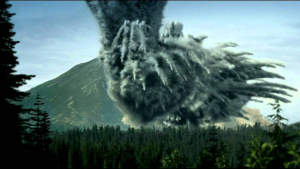 PMw 2021-095 by Kenneth L. Gentry, Jr.
PMw 2021-095 by Kenneth L. Gentry, Jr.
In Rev 6 one of the more dramatic images involves the shaking of all the mountains as God’s wrath falls. This is sometimes used as evidence against preterism and a first-century fulfillment of Rev. But does it undermine preterism? I think not. And here is why.
“And the sky was split apart like a scroll when it is rolled up; and every mountain and island were moved out of their places. And the kings of the earth and the great men and the commanders and the rich and the strong and every slave and free man, hid themselves in the caves and among the rocks of the mountains” (Rev. 6:14–15).
How shall we explain the moving of every mountain? What is the historical reality behind this apocalyptic imagery?
THE APOCALYPSE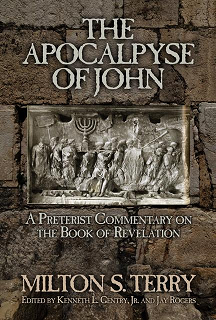 by Milton S. Terry
by Milton S. Terry
This book is Terry’s preterist commentary on the Book of Revelation. It was originally the last half of his much larger work, Biblical Apocalyptics. It is deeply-exegetical, tightly-argued, and clearly-presented.
See more study materials at: www.KennethGentry.com
To understand the imagery we must consider the first century circumstances involved in the Roman assault upon Israel. Much of Israel’s terrain around her important cities provided significant natural defenses serving as impediments to marauding armies. This is especially true for the armed forces of the highly ordered and mechanized Roman armies. Josephus frequently mentions the mountain impediments facing the Romans:
“Agrippa observed that even the affairs of the Romans were likely to be in danger, while such an immense multitude of their enemies had seized upon the mountains round about” (War 2:19:3).
“Now Jotapata is almost all of it built on a precipice, having on all the other sides of it every way valleys immensely deep and steep, insomuch that those who would look down would have their sight fail them before it reaches to the bottom. It is only to be come at on the north side, where the utmost part of the city is built on the mountain, as it ends obliquely at a plain. This mountain Josephus had encompassed with a wall when he fortified the city, that its top might not be capable of being seized upon by the enemies. The city is covered all round with other mountains, and can no way be seen till a man comes just upon it. And this was the strong situation of Jotapata.
Therefore, in order to try how he might overcome the natural strength of the place, as well as the bold defense of the Jews, made a resolution to prosecute the siege with vigor. To that end he called the commanders that were under him to a council of war, and consulted with them which way the assault might be managed to the best advantage” (War 3:7:7–8).
“A great multitude prevented their approach, and came out of Jericho, and fled to those mountainous parts that lay over against Jerusalem, while that part which was left behind was in a great measure destroyed; they also found the city desolate. It is situated in a plain; but a naked and barren mountain, of a very great length, hangs over it, which extends itself to the land about Scythopolis northward, but as far as the country of Sodom, and the utmost limits of the lake Asphaltiris, southward. This mountain is all of it very uneven and uninhabited, by reason of its barrenness” (War 4:8:2).
The Climax of the Book of Revelation (Rev 19-22)
Six lectures on six DVDs that introduce Revelation as a whole, then focuses on its glorious conclusion. Provides an important, lengthy Introduction to Revelation also.
See more study materials at: www.KennethGentry.com
A remarkable feature of Roman siege warfare lies behind the image of the mountains being moved. The Roman legions included demolition crews who labored to overcome the mountainous defenses facing them. The moving of every mountain out of their places symbolizes their successful work, as recorded by Josephus.
“Now Vespasian was very desirous of demolishing Jotapata, for he had gotten intelligence that the greatest part of the enemy had retired thither, and that it was, on other accounts, a place of great security to them. Accordingly, he sent both foot-men and horsemen to level the road, which was mountainous and rocky, not without difficulty to be traveled over by footmen, but absolutely impracticable for horsemen. Now these workmen accomplished what they were about in four days’ time, and opened a broad way for the army” (War 3:7:3).
“But Titus, intending to pitch his camp nearer to the city than Scopus, placed as many of his choice horsemen and footmen as he thought sufficient opposite to the Jews, to prevent their sallying out upon them, while he gave orders for the whole army to level the distance, as far as the wall of the city. So they threw down all the hedges and walls which the inhabitants had made about their gardens and groves of trees, and cut down all the fruit trees that lay between them and the wall of the city, and filled up all the hollow places and the chasms, and demolished the rocky precipices with iron instruments; and thereby made all the place level from Scopus to Herod’s monuments, which adjoined to the pool called the Serpent’s Pool” (War 5:3:2).
These dramatic historical occurrences in Josephus fit well with the dramatic, symbolic prophecies of John. And given the near-term expectation established by John and the absurdity of a direct literal interpretation, nothing hinders the reasonable interpreter from recognizing these events as the historical fulfillments in view.
December 28, 2021
SATAN’S “SYNAGOGUE” IN REVELATION
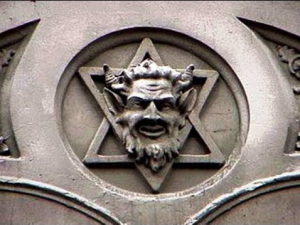 PMW 2021-094 by Kenneth L. Gentry, Jr.
PMW 2021-094 by Kenneth L. Gentry, Jr.
In Rev 2:9 (cp. 3:9) we read Jesus saying to Pergamum: “‘I know your tribulation and your poverty (but you are rich), and the blasphemy by those who say they are Jews and are not, but are a synagogue of Satan.” Evangelical commentator Ramsey Michaels argues that the false Jews of “the synagogue of Satan” are actually non-Jews, just like the “false apostles” in the letter to the church at Ephesus were not actual apostles. In fact, this is the majority view among Rev commentators.
Against this position I would urge the following
First, why would anyone in the first-century Roman empire other than a racial Jew claim to be a Jew? The Jews were detested in the Roman world:
1. They were driven out of Rome under Claudius for causing riots;
2. Tacitus claims of the Jews “the rest of the world they confront with the hatred reserved for enemies” and are “a most lasivious people” (Histories, 5);
3. According to Suetonius (Tiberius, 36), Tiberius “abolished foreign cults at Rome, particulary the Egyptian and Jewish, forcing all citizens who had embraced these superstitious faiths to burn their religious vestments and other accessories. Jews of military age were removed to unhealthy regions, in the pretext of drafting them into the army; the others of the same race or of similar beliefs were expelled from the city and threatened with slavery if they defied the order.”
Perilous Times: A Study in Eschatological Evil (by Ken Gentry)
Technical studies on Daniel’s Seventy Weeks, the great tribulation, Paul’s Man of Sin, and John’s Revelation.
See more study materials at: www.KennethGentry.com
4. They ultimately were attacked and destroyed by the Roman armies in AD 70 (and since Michaels holds that Revelation was written after AD 70, this would seem to greatly weaken his observation).
Second, the word “synagogue” is a distinctively Jewish place of worship. It is often used in the New Testament of the Jewish meeting house in the first century (e.g., Matt 4:23; 9:35; 23:34; Mark 1:39; 4:22; 6:2; Luke 4:15–20; 6:6; 8:41; 13:10; John 6:59; 9:22; 18:20; Acts 6:9; 9:2; 13:5; 14:1; etc.). The word “synagogue” occurs sixty-eight times in the New Testament and is always used of the Jewish place of worship.
Third, the whole character of Revelation seems to emphasize that Christianity is the true Israel of God, and would suggest John’s put down of Judaism among ethnic, literal Jews:
1. The 144,000 from the 12 tribes surely speaks of Christianity under Jewish imagery (and probably refers to the Jewish Christians in Israel). They are the perfect number, who are set over against those who “pierced” the Messiah (Rev. 1:7).
2. The New Jerusalem is from heaven and seems to replace the old (Rev. 11; Rev. 21; cp. Gal. 4:20ff; Heb. 12:18ff). We should note that the Epistle to the Hebrews similarly contrasts Christianity with the old Jewish order about to be shaken — as made with hands (Heb. 12:27, 28 cp. Heb. 9:11, 24).
3. Christ’s marriage to the bride from heaven, the new Jerusalem, seems to imply the putting away of God’s old wife, the old Jerusalem. She is capitally punished for spiritual adultery so that the new bride might lawfully be taken..
Fourth, the “synagogue of Satan” fits well with John’s imagery in his Gospel, where he records Jesus’s charge that the leaders of Israel are “of your father the devil” (John 8:44). John’s Gospel has a well-known strain of antagonism against “the Jews” (the leadership of Israel?). In fact, many liberal theologians deem it to be anti-Semitic. This would fit well with John’s Revelation and its declaration that Jews have become a “synagogue of Satan.”
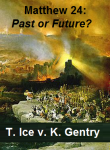
Matthew 24 Debate: Past or Future?
(DVD by Ken Gentry and Thomas Ice)
Two hour public debate between Ken Gentry and Thomas Ice on the Olivet Discourse.
See more study materials at: www.KennethGentry.com
Fifth, P. W. L. Walker’s excellent Jesus and the Holy City (Eerdmans, 1996) shows how, for instance, Matthew and Luke set up Christianity as the true Israel over against the Jewish claims. In a book as obviously Jewish as Revelation (Hebraic grammar, old covenant images, Old Testament allusions, etc.) we should expect an even more obvious attempt to present Christianity as the true Israel of God.
Thus, “the synagogue of Satan” attended by those who “call themselves Jews” surely refers to organized Judaism. And in the two diaspora cities of Pergamum and Smyrna, it undoubtedly refers to actual assemblies of the Jews.
December 24, 2021
EDEN ANIMALS EATING
 PMW 2021-093 by Kenneth L. Gentry, Jr.
PMW 2021-093 by Kenneth L. Gentry, Jr.
In some passages the kingdom of God is pictured in terms of Eden renewed, entailing peaceable conditions. But in our fallen world the lion’s deadly and terrifying power serves as a proverbial image in the Old Testament (Num. 23:24; Psa. 7:2; 17:12; Prov. 19:12; 20:2; 28:15; Isa. 38:13). Yet gentle carnivores are images of the fullness of God’s kingdom. For instance, carnivores are seen living in harmony with herbivores, though herbivores are their natural prey in Moses’ and our post-fall world (Gen. 49:9, 27; Deut. 33:20; Psa. 104:21; Isa. 5:29; Nah. 2:12).
And in Isaiah 11:6–7 we read that “the wolf will dwell with the lamb, / And the leopard will lie down with the young goat, / And the calf and the young lion and the fatling together; / And a little boy will lead them. / Also the cow and the bear will graze, / Their young will lie down together, / And the lion will eat straw like the ox” (see also Isa 65:25). Prophecies of God’s victory often reflect pre-Fall, Edenic conditions (e.g. Eze. 36:35; 47:1–12; Isa. 51:3; Rev 2:7; 22:2).
If such images reflect the actual historical reality of Eden, then peaceable conditions prevailed in the pre-Fall world and were radically changed upon the Fall. The postmillennialist believes with the amillennialist that these images are pictures of the spiritual reality that prevails when men are redeemed by the Prince of Peace. However, the postmillennialist also sees this spiritual reality of peace among men as also gradually unfolding in history as the gospel takes root and spreads before the end.
 As It Is Written: The Genesis Account Literal or Literary?
As It Is Written: The Genesis Account Literal or Literary?
Book by Ken Gentry
Presents the exegetical evidence for Six-day Creation and against the Framework Hypothesis. Strong presentation and rebuttal to the Framework Hypothesis, while demonstrating and defending the Six-day Creation interpretation.
See more study materials at: www.KennethGentry.com
Many Christians committed to theistic evolution (necessarily) disagree with any original passivity of such beasts. For instance, Meredith Kline, for instance, argues that “Psalm 104:21 seems to indicate clearly that the Creator had from the outset granted to predatory beasts to feed on other animals.” That verse reads: “The young lions roar after their prey /And seek their food from God.” But this does not speak of the lion’s original behavior. It is speaking in the present, and highlighting God’s governance of all of life in that “the earth is full of Your possessions” (Psa. 104:24c). Neither does Psalm 104:26a imply of the seas in creation week that “there the ships move along.”
Kline also points to 1 Timothy 4:3–4 as evidence for animal death from the beginning of creation: “false teachers who were forbidding some of them to marry and others forbidden to eat various kinds of foods and meats. Paul says it’s all wrong thinking here, because, God made these things, all of them to be received with thanksgiving. They’re all good. So, here’s the language of God’s intention from the beginning in creating them.” There Paul states: “men who forbid marriage and advocate abstaining from foods which God has created to be gratefully shared in by those who believe and know the truth. For everything created by God is good, and nothing is to be rejected if it is received with gratitude.”
How shall we reply?
Paul is dealing with Gnostics who believe the material realm is in itself evil. As the Dictionary of Paul and His Letters (DPL 661) notes regarding the mission works of Timothy and Titus: “They were increasingly endangered by a judaizing-gnostic countermission (1 Tim 1:3–7, 19–20; 4:1–2; 6:20; 2 Tim 4:3–4; Tit 1:10–16) . . . that included church leaders and probably former co-workers (2 Tim 1:15–18; 2:16–17; 3:6–9; 4:10; Tit 3:9–14).” An “essential feature of Gnosticism” was “an opposition between the spiritual world and the evil, material world” (DPL 350), which led them to abstain from meat as a feature of their “gnostic asceticism” (DPL 353).Paul’s fundamental point against these false teachers is that “everything created by God is good” (1 Tim. 4:4a). Yet the Gnostics are declaring certain foods to be evil in themselves — despite the fact that God created them.

The Book of Revelation Made Easy (by Ken Gentry)
Helpful introduction to Revelation presenting keys for interpreting. Also provides studies of basic issues in Revelation’s story-line.|
See more study materials at: www.KennethGentry.com
Interestingly, in 1 Timothy 4:3a Paul uses the generic word “food” (br ma) rather than the specific word for “meat” (kreas, “flesh”). Consequently, he is referring to “foods which God has created to be gratefully shared in” (1 Tim. 4:3b). Clearly he is not declaring all God-created foods to be always received and “gratefully shared in” throughout all times from the beginning of time. After all, Adam was forbidden to partake of the fruit of the tree of the knowledge of good and evil (Gen. 2:15–17; 3:11). Though it was food that God created (Gen. 1:11; 3:6), it could not be taken and “gratefully shared in.”
Nor could faithful saints under the old covenant partake of unclean animals (Lev. 11:4ff; Deut. 14:7ff; Acts 10:14). Though God created them, they could not be taken and “gratefully shared in.” And though in Paul’s context regarding eating, he declares that “everything created by God is good,” surely he does not allow for cannibalism to supply food to be “gratefully shared in.”
Calvin notes that in 1 Timothy 4, the “creatures are called pure not just because they are God’s works, but because they are given to us with His blessing. We must always have regard to God’s appointment, both what He commands and what He forbids.” After all, our food “is sanctified by means of the word of God and prayer” (1 Tim. 4:5). This requires a directive from God (through his word) along with prayer. In fact, God does not allow man to eat meat until after he establishes his covenant with Noah: “Every moving thing that is alive shall be food for you; I give all to you, as I gave the green plant” (Gen. 9:3). So likewise, before the Fall man was directed only to eat vegetation (Gen. 1:29) — which could be taken and “gratefully shared in.”
I do not believe that Adam and Eve crept through the Garden of Eden, singing “Lions, and tigers, and bears! Oh my!” Nor do I believe that God’s people will always endure enmity in the earth which is the Lord’s. As this blog shows in many ways, we may rightly expect the eventual victory of God’s kingdom in the world.
December 21, 2021
WAS ISAIAH A GRADUALIST?
PMW 2021-092 by Kenneth L. Gentry, Jr.
 In this article I am continuing a response to a reader who wonders if the NT teaches a gradualistic development of Christ’s kingdom to victory. He was especially curious since Rom 8 appears to speak of the fulfillment of Isa 11, with Rom 8 speaking of the consummation rather than history. I recommend reading my previous article to get his particular question before you.
In this article I am continuing a response to a reader who wonders if the NT teaches a gradualistic development of Christ’s kingdom to victory. He was especially curious since Rom 8 appears to speak of the fulfillment of Isa 11, with Rom 8 speaking of the consummation rather than history. I recommend reading my previous article to get his particular question before you.
Postmillennial gradualism and the final order
Postmillennialists not only believe in a large measure of historical victory for Christ’s kingdom but also that we are to expect a final, absolutely perfect order in eternity. We do believe that the whole creation is now groaning under the weight of sin which shows its effect in bodily weakness (Rom 8:22–23). We also believe that even at the very height of kingdom victory before Christ returns and history ends, sin will remain. Even when Christianity has gained ascendency, all will not be perfect, there will still be aging, dying, and groaning. Because there still will be sin. Death is the last enemy; it will be finally defeated in fulness at Christ’s return (1 Cor 15:26, 42–58). See my chapter in: Kenneth Gentry, ed., Thine Is the Kingdom: The Postmillennial Hope.
In addition, we argue that the historical advance of the postmillennial kingdom points to final consummate glory. And this finds an analogy in our own personal experience. We each long for full sanctification in the eternal state, even while we are growing in sanctification here on the earth. Our current gradual growth in grace is a pointer to our final, full sanctification in eternity. Likewise, the kingdom’s growth upon the earth develops the glory-principle on earth even as it looks forward to the full fruit of that glory beyond this fallen realm.
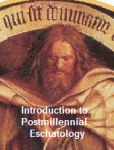
Introduction to Postmillennial Eschatology (10 mp3 lectures)
Southern California Center for Christian Studies seminar.
Lecture presentations and some classroom interaction.
Very helpful definition, presentation, and defense of postmillennialism.
See more study materials at: www.KennethGentry.com
Theologians have discerned the Now / Not Yet principle in biblical theology. That is, they recognize that since the first coming of Christ to establish the new covenant, the eternal order exists in seed form even now in history. We can see this in two clear examples from the NT. Just as we long for a future bodily resurrection (John 5:28–29), even now we are spiritually resurrected in Christ (John 5:24–25; Eph 2:6). Even as we long for the consummate, perfected new creation (2 Pet 3:13), we are now a spiritual new creation growing toward that end (2 Cor 6:17; Gal 6:15).
Thus, we enjoy the “Now” even as we long for its fuller expression in the “Not Yet.” The Now / Not Yet principle fits perfectly in postmillennial theology regarding the kingdom.
But now, where in the NT do we find any mention of historical victory for the gospel by means of gradualistic development? My inquirer asks: “apart from 1 Corinthians 15 (‘and he must reign…’) and The Parable of the Mustard Seed and leaven in the lump, I see very little in the New Testament itself which seems to envision the slow growth of the kingdom resulting in a victorious display within an historic millennium.”
Postmillennial gradualism in the NT
Let me respond to the reader’s concern by offering the following:
First, to ask the question in this way effectively answers the underlying concern, which is: Is the teaching of gradualistic kingdom victory biblical? By that I mean, the questioner opens with an admission that gradual victory is, in fact, taught in Scripture, at least in 1 Corinthians 15 and in the Parable of the Mustard Seed. If it is taught in those places by Christ and by Paul, then it is manifestly biblical.
Second, attached to the Parable of the Mustard Seed is its twin parable, the Parable of the Leaven (Matt 13:31–33). The Mustard Seed to presents the kingdom’s external growth (from small seed to large plant), whereas the Leaven Parable teaches its penetrating power (leaven gradually permeates three bushels). Both of these truths are significant for the postmillennial scheme: the victory will come to dominance, it will come gradually, and it will do so from growth within rather than imposition from without.
Third, contained within this same set of Kingdom Parables is another one that teaches the kingdom’s remarkable growth: the Parable of the Sower and Soils. In this parable, the Sower (Christ) sows seed (the gospel) in the earth with the following result: some seed “fell on the good soil and yielded a crop, some a hundredfold, some sixty, and some thirty” (Matt 13:8).
It is true that this is one of four soils upon which the seeds land, and the other three do not grow well, if at all. Nevertheless, the Sower surely prepared his garden for planting so that most of it involved good soil. Though there are four types of soil this does not mean that three-fourths of the seed fail. Otherwise the Sower would be shown as incompetent. The soil to which he aims his seed surely receives the most seed. And that seed produces remarkably well.
Fourth, Jesus gives still another parable that teaches the same gradualistic truth: the Parable of the Seed. In Mark 4:26-29 we read: “The kingdom of God is like a man who casts seed upon the soil; and he goes to bed at night and gets up by day, and the seed sprouts and grows—how, he himself does not know. The soil produces crops by itself; first the blade, then the head, then the mature grain in the head.” Though this one does not speak of the kingdom’s dominance, it does present its developmental growth. And in Mark 4 this leads into the Mustard Seed Parable (Mark 4:30–32).
Fifth, before his crucifixion Jesus promised his disciples: “Now judgment is upon this world; now the ruler of this world will be cast out. And I, if I am lifted up from the earth, will draw all men to Myself” (John 12:31–32). Here he teaches that Satan is about to lose the power that has kept the nations beyond Israel from turning to God. And as a direct result of that casting out, he says he will be lifted up so that he might “draw all men to Myself.” This surely implies a gradual drawing, not everyone all at once. And it certainly speaks of a dominant influence, an influence that can be expressed as involving “all men.”
Sixth, after his crucifixion he presents to his disciples the Great Commission. In that Commission we have a truly great command that involves a great expectation: a promise and expectation of worldwide victory: “Go therefore and make disciples of all the nations, baptizing them in the name of the Father and the Son and the Holy Spirit, teaching them to observe all that I commanded you” (Matt 28:19–20a).
In that he introduces this command with the bold claim that he has “all authority” both “in heaven and on earth” (Matt 28:18), he certainly has the power to seek a great end. And a great end he does seek, for he commands them to “make disciples of all the nations.” He does not call them simply to be a witness to the nations or just to preach to the nations. But actually to disciple them by baptizing and teaching them. This entails global victory over the nations in that the nations are to be baptized and taught.
And we should note that the Great Commission requires gradualistic development. How can these eleven disciples (Matt 28:16) expect to disciple the whole world suddenly? Besides, he even braces them for the historical long run when he assures them by promising: “lo, I am with you always, even to the end of the age” (Matt 28:20b).
Seventh, besides all of this (and I could provide more, if space allowed), what about the many Old Testament references to the kingdom’s gradual development to victory? I would mention just a few samples. In Dan 2 the stone that destroys the evil statue “becomes a great mountain” (Dan 2:35). In Ezekiel 17:22–24 God promises to establish the kingdom as a small “sprig from the lofty top of the cedar.” Then he will nurture it until it becomes “a stately cedar.” In Ezekiel 47:1–9 redemption flows forth from God’s temple in stages. The waters of life initiate from under the altar, first “to the ankles” (47:3), then to the knees (47:4a), then to the loins (47:4b), then it “was a river that I could not ford” (47:5). As a result: “everything will live where the river goes” (Eze 47:9).
One additional comment
This series opened with a brief analysis of Isa 11 and its reference to the peaceable kingdom. In that glorious prophecy we read: “the wolf will dwell with the lamb, / And the leopard will lie down with the young goat, / And the calf and the young lion and the fatling together; / And a little boy will lead them” (Isa 11:6). These are natural enemies brought to peaceful coexistence. This certainly will be the case in the new heavens and new earth after all sin is removed.
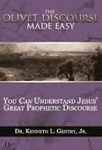
Olivet Discourse Made Easy (by Ken Gentry)
Verse-by-verse analysis of Christ’s teaching on Jerusalem’s destruction in Matt 24. Shows the great tribulation is past, having occurred in AD 70, and is distinct from the Second Advent at the end of history.
See more study materials at: www.KennethGentry.com
We must understand, however, that this too involves a Now / Not Yet operation. After all, Christ’s death effects peace between warring parties where the gospel gains victory. We clearly see this in Paul’s teaching in Eph 2:11–18, where such happens to be his main point:
Therefore remember that formerly you, the Gentiles in the flesh, who are called “Uncircumcision” by the so-called “Circumcision,” which is performed in the flesh by human hands— remember that you were at that time separate from Christ, excluded from the commonwealth of Israel, and strangers to the covenants of promise, having no hope and without God in the world. But now in Christ Jesus you who formerly were far off have been brought near by the blood of Christ. For He Himself is our peace, who made both groups into one and broke down the barrier of the dividing wall, by abolishing in His flesh the enmity, which is the Law of commandments contained in ordinances, so that in Himself He might make the two into one new man, thus establishing peace, and might reconcile them both in one body to God through the cross, by it having put to death the enmity. And he came and preached peace to you who were far away, and peace to those who were near; for through Him we both have our access in one Spirit to the Father.
December 17, 2021
VICTORY FIRST; THEN THE END
 PMW 2021-091 by Kenneth L. Gentry, Jr.
PMW 2021-091 by Kenneth L. Gentry, Jr.
Postmillennialism differs from the other evangelical eschatologies in a very important respect: Postmillennialism is optimistic about the progress of the gospel in history. We believe that Christ’s victory on the cross will exercise a tremendous influence in history — before the end, before the return of Christ.
We see this throughout the Scriptural record. Some amillennialists charge that postmillennialism is built solely on Old Testament texts, and that its optimistic outlook cannot be found in the New Testament. But that is absolutely mistaken. Let us consider one text in Paul as an example of Christ’s victory in history before his return: 1 Corinthians 15.
In 1 Corinthians 15:20-28 Paul teaches not only that Christ currently sits upon the throne, but also that he rules with a confident view to subduing his enemies in history. (In this discussion I will employ the New International Version as my basic English translation due to its greater fidelity to several particulars of the Greek grammar in this passage.)
But Christ has indeed been raised from the dead, the firstfruits of those who have fallen asleep. For since death came through a man, the resurrection of the dead comes also through a man. For as in Adam all die, so in Christ all will be made alive. But each in his own turn: Christ, the firstfruits; then, when he comes, those who belong to him. Then the end will come, when he hands over the kingdom to God the Father after he has destroyed all dominion, authority and power. For he must reign until he has put all his enemies under his feet. The last enemy to be destroyed is death. For he “has put everything under his feet.” Now when it says that “everything” has been put under him, it is clear that this does not include God himself, who put everything under Christ. When he has done this, then the Son himself will be made subject to him who put everything under him, so that God may be all in all.
Greatness of the Great Commission (by Ken Gentry)
An insightful analysis of the full implications of the great commission. Impacts postmillennialism as well as the whole Christian worldview.
See more study materials at: www.KennethGentry.com
The End
In 1 Corinthians 15:20–22 Paul speaks of the resurrection order: Christ is resurrected as a first fruits promise of our resurrection. In verses 23–24 we read about the sequence of events involving the resurrection: “But each in his own turn: Christ the first fruits; then, when he comes, those who belong to him. Then the end will come.” We today are currently in the era awaiting Christ’s end-time coming, when all believers will arise in resurrection glory. When Christ comes this will be “the end”! Scripture is clear that the resurrection is a “general resurrection” of both the righteous and unrighteous (John 5:28–29; Acts 24:15), which will occur on the “last day” (John 6:39–40, 44, 54; 11:24; 12:48). Thus, according to Paul (and Jesus) no millennial age will follow. The resurrection of believers occurs on the “last day,” not 10071 years before the “last day.”
But notice what precedes the end. First Corinthians 15:24 says: “the end will come, when he hands over the kingdom to God the Father.” Earth history ends “whenever” 2 Christ “hands over” the kingdom to the Father. In the Greek structure before us, his “handing over” (NIV) or “delivering up” (KJV) the kingdom occurs simultaneously with “the end.” Here the timing is contingent: “whenever” he delivers up the kingdom, then the end will come. In addition, he will deliver up his kingdom to the Father only “after he has destroyed all dominion, authority and power.”
So then, the end of history is contingent: it will come whenever it may be that Christ delivers up the kingdom to his Father. But this will not occur until “after He has destroyed all dominion, authority and power” (see also: ESV). Consequently, the end will not occur, and Christ will not turn the kingdom over to the Father, until after he has abolished all opposition. Here again we see the gospel victory motif in the New Testament in a way co-ordinate with Old Testament covenantal and prophetic expectations.
Before the End
Notice further that 1 Corinthians 15:25 demands that “He must reign until He has put all His enemies under His feet.” Here the present infinitive for “reign” indicates an ongoing reign that exists as Paul writes. Christ is presently reigning, and has been so since his ascension. References elsewhere to Psalm 110 specifically mention his sitting at God’s right hand, which entails active ruling and reigning, not passive resignation or anxious waiting. As John informs us, Jesus is now “the ruler over the kings of the earth” and “has made us kings and priests to His God and Father, to Him be glory and dominion forever and ever” (Rev 1:5–6; cp. Rev 3:21).
Special Eschatology Studies (3 MP3 downloads)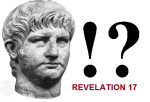
by Ken Gentry
Includes: (1) Radio interview on the Beast and Daniel 9: WMCA Radio (New York). (2) “The Beast is an Eighth,” a study on the tricky verse Rev 17:11 that is sometimes used to rebut the Neronic date for the writing of Revelation. (3) “The New Creation in Rev 21,” which presents a picture of the glory of the Christian faith as the spiritual phase of the New Creation that anticipates the consummate New Creation. See more study materials at: www.KennethGentry.com
Thus, in 1 Corinthians 11:25 Paul states that Christ must continue reigning as he puts his enemies under his feet. But to what point in time does his reign continue? The answer is identical to our previous conclusion: his reign from the right hand of God in heaven extends to the end of history. We must understand his rule as definitive, progressive, and consummative. That is, during his earthly ministry he awaits his resurrection in order to secure the definitive (legal) right to all rule, authority and power (Matt 28:18; Eph 1:19–22; Phil 2:9–11; 1 Pet 3:21–22). Now that he rules from heaven until he returns, his return is delayed until he progressively (actively, continually) puts “all His enemies under His feet” (Paul’s repeating the fact of his sure conquest before the end is significant). Then consummatively (finally and fully), he will subdue our “last enemy,” death, by means of the final resurrection at his coming.3 Thus, Church history begins with his legal victory at the cross-resurrection-ascension, continues progressively as he subdues all of his other enemies, and ends finally at the eschatological resurrection, which conquers the final enemy, death.
In 1 Corinthians 15:27 Christ clearly has the legal title to rule, for the Father “has put everything under His feet.” This expression (borrowed from Psa 8:6) corresponds with Christ’s declaring that “all authority has been given Me” (Matt 28:18). He has both the right to victory as well as the promise of victory. Psalm 110, especially as expounded by Paul in 1 Corinthians 15, shows that he will secure historical victory over all earthly opposition before his second advent — in time and on earth.
For a Spanish version of this article by Fredi Sosa of Paraguay, see: https://reinoinconmovible.wordpress.com/2015/12/29/la-victoria-entonces-viene-el-fin/
December 14, 2021
WILL HE FIND FAITH ON THE EARTH?
 PMW 2021-090 by Kenneth L. Gentry, Jr.
PMW 2021-090 by Kenneth L. Gentry, Jr.
In Luke 18:8 Jesus makes a statement that seems to undermine any notion of the postmillennial hope. There we read:
“I tell you that He will avenge them speedily. Nevertheless, when the Son of Man comes, will He really find faith on the earth?”
Dispensationalists employ this verse with great confidence against postmillennialism. And we can certainly see why. Consider the following comments by dispensationalists.
Wayne House and Thomas Ice: “This is ‘an inferential question to which a negative answer is expected.’ So this passage is saying that at the second coming Christ will not find, literally, ‘the faith’ upon the earth.”
Hal Lindsey writes: “In the original Greek, this question assumes a negative answer. The original text has a definite article before faith, which in context means ‘this kind of faith.’”
Borland agrees: “The faith spoken of is probably the body of truth, or revealed doctrine, since the word is preceded by the definite article in the original. Improvement in the worldwide spiritual climate is not here predicted.”
Wiersbe follows suit: “The end times will not be days of great faith.” [1]
This verse is also brought out by amillennialists, such as R. B. Kuiper, Herman Hanko, Donald Bloesch, and Kim Riddlebarger, [2] as well as premillennialists such as Wayne Grudem. [3] Indeed, amillennialist D. Martyn Lloyd-Jones dogmatically asserts: “There is one verse, one statement, which, as far as I am concerned, is enough to put the postmillennial view right out. It is Luke 18:8.” [4] Bloesch declares that postmillennialism “flatly contradicts Jesus’ intimation” here in Luke 18:8. [5]
In the Days of These Kings: The Book of Daniel in Preterist Perspective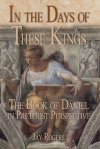
by Jay Rogers
This orthodox preterist analysis of Daniel is not a book, but a library. Extremely helpful for the postmillennial orthodox preterist.
For more study materials, go to: KennethGentry.com
But things are not what they appear to be. So I would like to note several avenues of rebuttal. As postmillennialists, we may, in fact, be warmed and filled!
First, we must determine the focus of the question.
Some doubt exists regarding whether this question is even dealing with Christianity’s future existence as such. In the context, the Lord is dealing with the matter of fervent prayer. The definite article that Borland thinks must refer to “the body of truth, or revealed doctrine” seems rather to refer to the faith in prayer evidenced in the importune widow’s persistence: “Then He spoke a parable to them, that men always ought to pray and not lose heart” (Lk 18:1). Here Christ is asking if that sort of persistent prayer will continue after he is gone.
B. B. Warfield demonstrates that the reference to “the faith” has to do with the faith-trait under question in the parable: perseverance. He doubts the reference even touches on whether or not the Christian faith will be alive then, but rather: Will Christians still be persevering in the hope of the Lord’s vindicating their cause? As in Matthew 7:13–14, He was urging them to keep persevering. [6] This interpretation of the meaning of “the faith,” appears among non-premillennialists,[7] as well as premillennialists and even some dispensationalists. [8]
Second, we must determine the expectation in the question.
Even if it does refer to the Christian faith or the system of Christian truth, why is a negative prospect expected? As with the Matthew 7:13–14 passage, could not Christ be seeking to motivate his people, encouraging them to understand that the answer issues forth in an optimistic prospect? In another context was not Peter’s answer to such a query optimistic (Jn 6:67, 68)? Could it not be that the question is asked for the purpose not of speculation but of self-examination?
In point of fact, the question does not “assume” a negative answer at all. It is not a rhetorical question. The Funk-Blass-Debrunner Greek grammar notes that when an interrogative particle is used, as in Luke 18:8, “ou is employed to suggest an affirmative answer, me (meti) a negative reply” (p. 226 § 440). But neither of these particles occurs here. Thus, the implied answer to the question is “ambiguous” (p. 226), because the Greek word used here (ara) implies only “a tone of suspense or impatience in interrogation” (BAGD, 127).
The Harrowing of Hell (by Jay Rogers)
This postmillennial book examines the power of the Gospel, not only to overcome all opposition, but to rise far above the powers of hell. The term “Harrowing of Hell” refers to idea that Christ descended into Hell, as stated in the Apostles’ Creed.
For more Christian educational materials: www.KennethGentry.com
Third, we must determine the terminus in view in the question.
Apparently, Christ has in mind his imminent coming in judgment upon Israel, not his distant second advent to end history. Christ clearly speaks of a soon vindication of his people, who cry out to him: “I tell you that He will avenge them speedily” (Lk 18:8a; cp. Rev 1:1; 6:9–10). He is urging his disciples to endure in prayer through the troublesome times coming upon them, just as he does in Matthew 24:13, which speaks of the first century generation (Mt 24:34). In fact, the preceding context of Luke 18 speaks of Jerusalem’s destruction (Lk 17:22–37).
Fourth, we must determine the implication of millennial views regarding the question.
In the final analysis, no evangelical millennial view supposes that absolutely no faith will exist on the earth at the Lord’s return. Yet, to read the statements I quote above regarding Luke 18:8 and its supposedly expecting a negative answer, one would surmise that Christianity will be totally and absolutely dead at his return.
Thus, non-postmillennialists cannot successfully employ this passage against postmillennialism. Its standard is misinterpreted: The Lord’s teaching regarding fervent prayer is changed into a warning regarding Christianity’s future. Its grammar is misconstrued: The grammar indicating concern becomes an instrument of doubt. Its goal is radically altered: Rather than speaking of soon-coming events, it supposedly points to history’s distant end. Its final result is overstated (even if all the preceding points be dismissed): No critic of postmillennialism teaches that “the faith” will entirely and completely vanish from the earth at Christ’s Return.
There now. I feel better already!
Notes
1. House and Ice, Dominion Theology, 229. Lindsey, The Road to Holocaust, 48. Borland in Liberty Commentary on the New Testament, 160. Wiersbe, Bible Exposition Commentary, 2:249.
2. Kuiper, God-Centered Evangelism, 209. Hanko, “An Exegetical Refutation of Postmillennialism,” 16. Bloesch, Last Things, 57. Riddlebarger, Case for Amillennialism, 237.
3. Grudem, Systematic Theology, 1124.
4. Lloyd-Jones, The Church and the Last Things, 217.
5. Bloesch, Last Things, 103.
6. Warfield, “The Importune Widow and the Alleged Failure of Faith,” in Warfield, Selected Shorter Writings of Benjamin B. Warfield, 2:698–710. See also: Marshall, Luke, 676.
7. Hendriksen, Luke, 818. Green, Luke, 642–43. Evans, Luke, NIBC. Nolland, Luke, 870.
8. Alford, Luke, 614. Robertson, Word Pictures, 2:232. Bock, Luke 2:1455–56.
9. Funk, A Greek Grammar of the New Testament, 226 (§ 440).
Kenneth L. Gentry Jr.'s Blog
- Kenneth L. Gentry Jr.'s profile
- 85 followers


